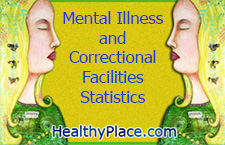A Broken System: Mental Illness and Correctional Facilities (pt 2)
Sometimes statistics speak for themselves. In 2005, PBS aired a documentary about psychiatric treatment in the correctional system. Here is a breakdown by state:
Mentally Ill Inmates State-by-State
 Alabama—24 percent of the state’s 27,913 inmates were diagnosed as mentally ill
Alabama—24 percent of the state’s 27,913 inmates were diagnosed as mentally ill
Alaska—10.8 percent of the state’s 2,657 inmates were in counseling, 9 percent were receiving psychiatric medication
Arizona—15 percent of the state’s 31,170 inmates were diagnosed as mentally ill
Arkansas—6 percent of the state’s 13,084 inmates were diagnosed as mentally ill
California—16.7 percent of the state’s 164,487 inmates were diagnosed as mentally ill
Colorado—16 percent of the state’s 19,671 inmates were diagnosed as mentally ill
Connecticut—13 percent of the state’s 19,846 inmates were diagnosed as mentally ill
Delaware—13.63 percent of the state’s 6,704 inmates were diagnosed as mentally ill
Florida—14.9 percent of the state’s inmates were in counseling, 10,8 percent were receiving psychiatric medication
Georgia—15.1 percent of the state’s 47,208 inmates were diagnosed as mentally ill
Hawaii—15 percent of the state’s 5,828 inmates were diagnosed as mentally ill.
Idaho—19 percent of the state’s 5,887 inmates were diagnosed as mentally ill
Illinois—9.9 percent of the state’s 44,000 inmates were in counseling, 6.7 were receiving psychiatric medication. Not all prisons responded, so these percentages may be low.
Indiana—11 percent of the state’s 23,069 inmates were diagnosed as mentally ill
Iowa—18 percent of the state’s 8,546 inmates were diagnosed as mentally ill
Kansas—18 percent of the state’s 9,132 inmates were diagnosed as mentally ill
Kentucky—16 percent of the state’s 16,622 were diagnosed as mentally ill. In 2004, the state reported a waiting list for mental health treatment.
Louisiana—15 percent of the state’s 36,047 inmates were diagnosed as mentally ill
Maine—33 percent of the state’s 1,562 inmates were in counseling, 23.5 percent were receiving psychiatric medication
Maryland—14 percent of the state’s 23,791 inmates were diagnosed as mentally ill
Massachusetts—22 percent of the state’s 10,232 inmates were diagnosed as mentally ill
Michigan—10 percent of Michigan’s 49,358 inmates were diagnosed as mentally ill
Minnesota—25.5 percent of Minnesota’s 7,865 inmates were diagnosed as mentally ill
Mississippi—10 percent of the state’s 20,589 inmates were diagnosed as mentally ill. As of 2004, only two therapists were on staff, and no special training in managing mentally ill inmates was required for corrections officers or supervisors.
Missouri—13 percent of the state’s 30,303 inmates were diagnosed as mentally ill
Montana—12 percent of the state’s 2,233 inmates were in counseling, 21.4 percent were receiving psychiatric medication
Nebraska—17.5 percent of the state’s 4,040 inmates were diagnosed as mentally ill
Nevada—13 percent of the state’s 10,543 inmates were diagnosed as mentally ill
New Hampshire—18 percent of the state’s 2,434 inmates were diagnosed as mentally ill
New Jersey—12 percent of the state’s 27,246 inmates were diagnosed as mentally ill
New Mexico—12.5 percent of the state’s 6,223 inmates were diagnosed as mentally ill
New York—15 percent of the state’s 65,198 inmates were diagnosed as mentally ill. The state reported a waiting list for mental health treatment.
North Carolina—13.2 percent of the state’s 27,406 inmates were in counseling, 10.2 percent were receiving psychiatric medication. These percentages may be low as not every correctional facility responded.
North Dakota—25 percent of the state’s 1,239 inmates were diagnosed as mentally ill
Ohio—16 percent of the state’s 44,778 inmates were diagnosed as mentally ill
Oklahoma—14.6 percent of the state’s 23,013 inmates were in counseling, 11.8 percent were receiving psychiatric medication
Oregon—23.6 of the state’s 12,715 inmates were diagnosed as mentally ill
Pennsylvania—17 percent of the state’s 40,890 inmates were diagnosed as mentally ill
Rhode Island—15 percent of the state’s 3,527 inmates were diagnosed as mentally ill
South Carolina—9.2 percent of the state’s 23,719 inmates were diagnosed as mentally ill. No special training for managing mentally ill inmates was required for correctional officers and supervisors.
South Dakota—20 percent of the state’s 3,026 inmates were diagnosed as mentally ill
Tennessee—18 percent of Tennessee’s 25,403 inmates were diagnosed as mentally ill
Texas—11 percent of the state’s 166,911 inmates were diagnosed as mentally ill
Utah—10 percent of the state’s 5,763 inmates were diagnosed as mentally ill
Vermont—34.9 percent of the state’s 1,004 inmates were in counseling, 28.3 percent were receiving psychiatric care. These numbers may be low as not all correctional facilities responded.
Virginia—10.6 percent of the state’s 30,368 inmates were in counseling, 8.4 percent were receiving psychiatric medication
Washington—12 percent of the state’s 16,148 inmates were diagnosed as mentally ill
West Virginia—12.6 percent of the state’s 3,012 inmates were in counseling, 16.1 were receiving psychiatric medication
Wisconsin—25 percent of the state’s 22,614 inmates were diagnosed as mentally ill
Wyoming—37.3 percent of the state’s 2,186 inmates were in counseling, 17.3 percent were receiving psychiatric medications
- A Broken System: Mental Illness and Correctional Facilities (pt 1)
- A Broken System: Mental Illness and Correctional Facilities (pt 2)
- A Broken System: Mental Illness and Correctional Facilities (pt 3)
APA Reference
Oberg, B.
(2013, January 1). A Broken System: Mental Illness and Correctional Facilities (pt 2), HealthyPlace. Retrieved
on 2025, December 13 from https://www.healthyplace.com/blogs/borderline/2013/01/a-broken-system-mental-illness-and-correctional-facilities-part-two